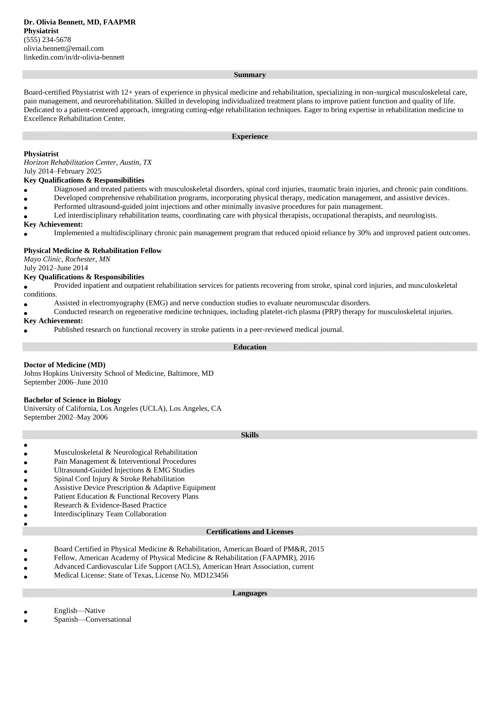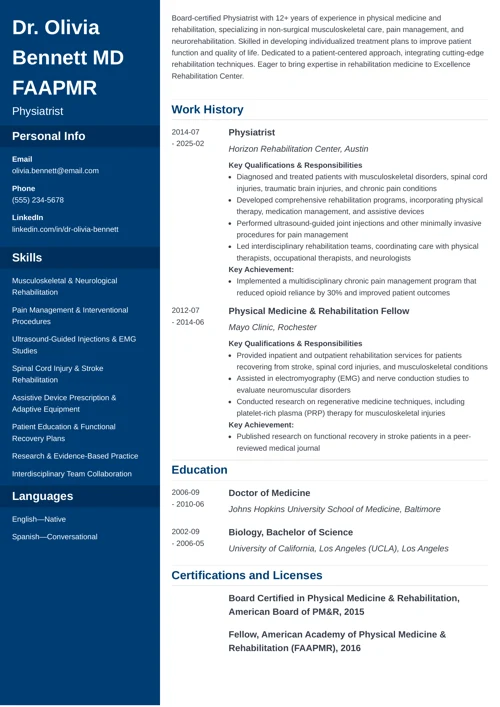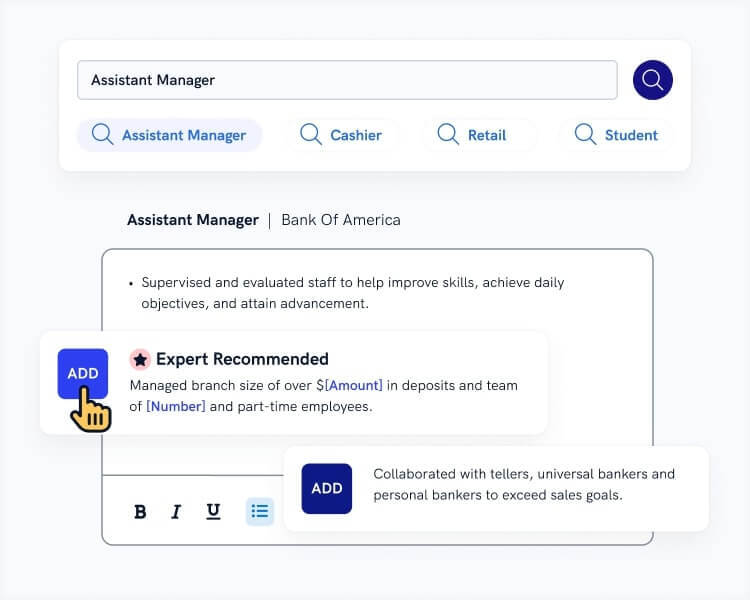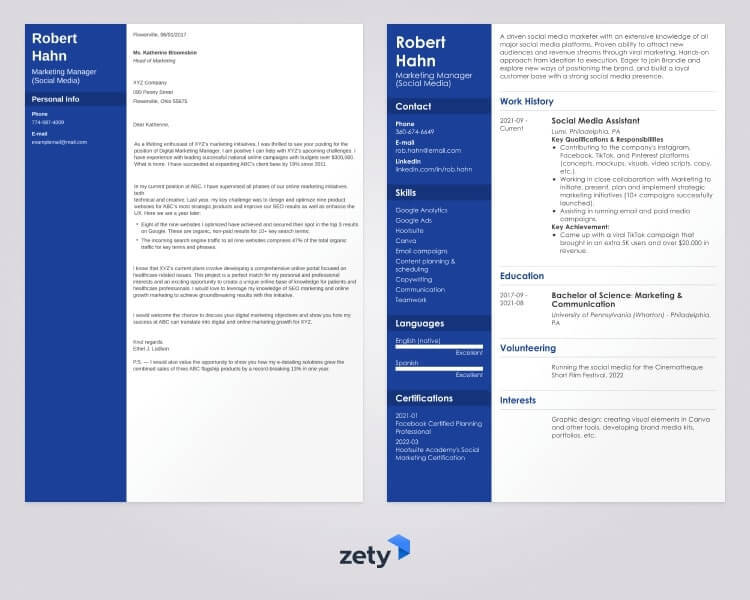Physiatrist Resume Examples & Template for 2025
Creating a job-winning physiatrist resume is crucial to establishing yourself in the competitive field of physical medicine and rehabilitation. This article offers expert guidance and detailed physiatrist resume examples, helping you emphasize your unique skills and experiences, making a lasting impression on potential employers. Let’s begin!
This guide will show you:
- An exceptional physiatrist resume example that outshines others.
- Strategies for constructing a physiatrist resume that attracts more interviews.
- Tips and examples for showcasing physiatrist skills in your resume.
- Techniques for presenting your experience effectively on a resume to secure any desired physiatrist role.
Want to save time and have your resume ready in 5 minutes? Try our resume builder. It’s fast and easy to use. Plus, you’ll get ready-made content to add with one click. See 20+ resume templates and create your resume here.
Sample resume made with our builder—See more resume examples here.
Interested in discovering more resume samples? Explore here:
- Medical Doctor Resume Example & Writing Guide
- Physician CV Example & Writing Guide
- Healthcare Professional Resume Example & Writing Guide
- Physical Therapist Resume Example & Writing Guide
- Therapist Resume Example & Writing Guide
- Physician Assistant Resume Example & Writing Guide
- Physical Therapy Aide Resume Example & Writing Guide
- Massage Therapist Resume Example & Writing Guide
- Occupational Therapist Resume Example & Writing Guide
- Resume Examples & Writing Guides for All Jobs
Physiatrist Resume Sample
Dr. Olivia Bennett, MD, FAAPMR
Physiatrist
(555) 234-5678
olivia.bennett@email.com
linkedin.com/in/dr-olivia-bennett
Summary
Board-certified Physiatrist with 12+ years of experience in physical medicine and rehabilitation, specializing in non-surgical musculoskeletal care, pain management, and neurorehabilitation. Skilled in developing individualized treatment plans to improve patient function and quality of life. Dedicated to a patient-centered approach, integrating cutting-edge rehabilitation techniques. Eager to bring expertise in rehabilitation medicine to Excellence Rehabilitation Center.
Experience
Physiatrist
Horizon Rehabilitation Center, Austin, TX
July 2014–February 2025
Key Qualifications & Responsibilities
- Diagnosed and treated patients with musculoskeletal disorders, spinal cord injuries, traumatic brain injuries, and chronic pain conditions.
- Developed comprehensive rehabilitation programs, incorporating physical therapy, medication management, and assistive devices.
- Performed ultrasound-guided joint injections and other minimally invasive procedures for pain management.
- Led interdisciplinary rehabilitation teams, coordinating care with physical therapists, occupational therapists, and neurologists.
Key Achievement:
- Implemented a multidisciplinary chronic pain management program that reduced opioid reliance by 30% and improved patient outcomes.
Physical Medicine & Rehabilitation Fellow
Mayo Clinic, Rochester, MN
July 2012–June 2014
Key Qualifications & Responsibilities
- Provided inpatient and outpatient rehabilitation services for patients recovering from stroke, spinal cord injuries, and musculoskeletal conditions.
- Assisted in electromyography (EMG) and nerve conduction studies to evaluate neuromuscular disorders.
- Conducted research on regenerative medicine techniques, including platelet-rich plasma (PRP) therapy for musculoskeletal injuries.
Key Achievement:
- Published research on functional recovery in stroke patients in a peer-reviewed medical journal.
Education
Doctor of Medicine (MD)
Johns Hopkins University School of Medicine, Baltimore, MD
September 2006–June 2010
Bachelor of Science in Biology
University of California, Los Angeles (UCLA), Los Angeles, CA
September 2002–May 2006
Skills
- Musculoskeletal & Neurological Rehabilitation
- Pain Management & Interventional Procedures
- Ultrasound-Guided Injections & EMG Studies
- Spinal Cord Injury & Stroke Rehabilitation
- Assistive Device Prescription & Adaptive Equipment
- Patient Education & Functional Recovery Plans
- Research & Evidence-Based Practice
- Interdisciplinary Team Collaboration
Certifications and Licenses
- Board Certified in Physical Medicine & Rehabilitation, American Board of PM&R, 2015
- Fellow, American Academy of Physical Medicine & Rehabilitation (FAAPMR), 2016
- Advanced Cardiovascular Life Support (ACLS), American Heart Association, current
- Medical License: State of Texas, License No. MD123456
Languages
- English—Native
- Spanish—Conversational
Here’s how to write your own physiatrist resume:
1. Format Your Physiatrist Resume Correctly
Your physiatrist resume must tackle a unique challenge: standing out in a sea of applicants. To captivate hiring managers and encourage them to read further, your resume should feature a professional and effective format that catches the eye.
To format your physiatrist resume effectively:
- Initiate with a distinctive resume header, including your name, phone number, email, LinkedIn, and an online portfolio link. These are essential contact details for your resume.
- While you can omit your street address, consider adding your town, especially if it's the same as the hiring company.
- Opt for a reverse-chronological resume format, listing your most recent position first. Recruiters prefer this resume layout because it aligns with their expectations.
- Select a professional font such as Calibri or Arial. The optimal resume font size ranges from 10 to 12 points.
- Name your resume file as “Your Name - Physiatrist - Resume.pdf.” A PDF resume format is preferable to Word as it maintains the layout consistently.
- The recommended resume length for entry-level physiatrists is one page. However, if you have significant accomplishments, a two-page resume might be more suitable.
Choose from the best resume templates to enhance your job application: Top Resume Templates
2. Customize Your Physiatrist Job Description
To make your resume truly impactful, you need to tailor it to the specific job you're applying for. A generic resume experience section may not capture the attention of a hiring manager. A list of generic duties can lead them to think, "Sure, they've been a physiatrist, but what did they really achieve?"
Here's how to effectively incorporate relevant experiences into your resume:
- Use the exact job title mentioned in the job advertisement. ATS-friendly resumes function optimally with precise job titles.
- Include the company name and employment dates, and accompany these with 3–6 bullet points. (More for recent roles, less for older ones.)
- Show how you have utilized relevant skills by listing accomplishments. The top resume achievements are quantifiable and highlight key performance indicators (KPIs).
- Start bullet points with powerful resume action words like coordinated, designed, and prepared.
Physiatrist Resume Examples: Responsibilities
- Conduct comprehensive patient assessments to formulate individualized rehabilitation plans.
- Collaborate with interdisciplinary teams to enhance patient care and recovery outcomes.
- Create exercise programs tailored to the unique needs and abilities of patients.
- Implement evidence-based treatment protocols to improve functional independence.
- Educate patients and families about rehabilitation processes and self-management strategies.
- Modify treatment plans based on patient progress and feedback.
- Ensure patient care records meet regulatory and quality standards.
Remember to use action verbs that convey your responsibilities and achievements effectively. Here are some action verbs for physiatrist resumes:
Physiatrist Resume Examples: Action Verbs
- Diagnosed
- Assessed
- Treated
- Prescribed
- Rehabilitated
- Evaluated
- Implemented
- Collaborated
- Administered
- Educated
Master the craft of crafting job descriptions for your resume: How to Write a Resume Job Description
3. Make Your Education Section Count
Listing your educational background on a resume is essential, but stopping at just the degree title, university name, and dates means you're not utilizing it to its full potential. To work as a physiatrist, you must complete a graduate medical degree followed by a residency in Physical Medicine and Rehabilitation (PM&R), making it even more important to highlight your education effectively on your resume.
Consider these resume tips:
- The ideal resume degree placement is right after your work history.
- For an entry-level physiatrist resume, include relevant classes to showcase your skills.
- Even with experience, you can add bullet points for fellowships, scholarships, or leadership roles.
- Should you include your GPA on a resume? Only if it's notably high.
Simplify your job application process with tips that enhance your candidacy: Job Application Process
Creating a resume with our builder is incredibly simple. Follow our step-by-step guide and use content from Certified Professional Resume Writers to have a resume ready in minutes.
When you’re done, Zety’s resume builder will score your resume and our resume checker will tell you exactly how to make it better.
4. Prove the Physiatrist Resume Skills the Company Wants
Including skills on a resume is necessary, but there's a strategic way to do it. You're aware of the need for a list of 5–10 physiatrist skills. However, if you select them haphazardly, you risk being overlooked. Instead, focus on the most crucial skills highlighted in the job advertisement.
Here's how to incorporate physiatrist skills into a resume:
- Skills listed in the job ad are resume keywords. Include them in your concise skill list.
- Avoid listing an excessive number of skills (like 20). Doing so may bury the skills the employer is seeking.
- To increase interview requests, ensure the skills in your list are also mentioned in your job and education bullet points.
Here are some hard and soft skills for a resume for physiatrists:
Sample Physiatrist Skills for Resumes
- Electrodiagnostic Testing (EMG/NCS)
- Musculoskeletal & Neuromuscular Assessment
- Spinal Cord Injury Rehabilitation
- Traumatic Brain Injury (TBI) Rehabilitation
- Orthotic & Prosthetic Prescription
- Pain Management (Injections, Nerve Blocks, etc.)
- Gait Analysis & Mobility Training
- Spasticity Management (Botulinum Toxin, Baclofen Pumps)
- Physical Therapy & Rehabilitation Planning
- Medical Documentation & EHR Systems
- Interpersonal Skills
- Verbal And Written Communication Skills
- Leadership Skills
- Organizational Skills
- Active Listening
- Problem-Solving Skills
- Time Management Skills
- Attention To Detail
- Stress Management
- Teamwork Skills
- Computer Skills
- Adaptability
Discover how being detail-oriented can become a powerful asset on your resume: Detail-Oriented: How to Show Off This Professional Skill
5. Add Other Sections to Your Physiatrist Resume
"The resume is great — but it’s still a risk. I wonder what this applicant is like to work with?" Hiring managers are curious about your energy and drive. Will you be the ideal employee who takes initiative and delivers results? Enhance your resume with additional sections to demonstrate you are that candidate.
Here are a few added sections that can show your professional strengths:
- Certifications: include relevant credentials such as Board Certification in Physical Medicine and Rehabilitation (ABPMR) or subspecialty certifications (e.g., Pain Medicine, Sports Medicine, Brain Injury Medicine).
- Publications & Research: if you’ve published articles in PM&R Journal, American Journal of Physical Medicine & Rehabilitation, or similar medical publications, list them to establish your authority in the field.
- Professional Associations: memberships in organizations like the American Academy of Physical Medicine and Rehabilitation (AAPM&R) or the International Society of Physical and Rehabilitation Medicine (ISPRM) demonstrate industry involvement.
- Volunteer Work: if you’ve participated in medical mission trips, community rehabilitation programs, or pro bono physical therapy initiatives, highlight these experiences.
- Language Skills: if you speak additional languages, mention them in your skills section, as they can be valuable for patient communication in diverse settings.
Find out how to write a reference letter that leaves a lasting impact on employers: Reference Letter
6. Write a Physiatrist Resume Objective or Resume Summary
Creating a compelling introduction is crucial to ensure your resume stands out in those crucial first moments. Our HR statistics report indicates that hiring managers spend just 6 to 7 seconds on initial reviews. Therefore, it's essential to grab their attention with a resume introduction that highlights the most critical aspects of your resume.
What we refer to as a resume profile serves as a quick snapshot of your professional persona. While some liken it to an elevator pitch of yourself, it's more concise—meant to capture interest in just one paragraph during that pivotal seven-second window.
For those with a year or more of professional experience, mention your tenure, current job title, how you can contribute to the company, and any significant achievements that stand out. This is your resume summary, which should be positioned prominently at the top.
If you're pondering how to write a resume with no experience, adopt a similar approach, but draw your accomplishments from academic projects, etc. These initial statements are known as objectives for a resume.
Prepare to impress in interviews by refining your answer to the classic question, Tell Me About Yourself, and leave a lasting impression.
7. Write a Cover Letter for Your Physiatrist Resume
Crafting a cover letter remains essential in today's job market. With so many applicants sending out resumes indiscriminately, a well-crafted cover letter shows genuine interest in the specific role and organization.
To design your resume cover sheet effectively:
- Implement a professional cover letter structure with consistent headers and a business-like closing.
- Follow proper cover letter formatting using 3-5 concise paragraphs, keeping it under a full page.
- Start your cover letter by mentioning the job title and an engaging introduction that encourages further reading.
- In the body, highlight key achievements from your resume that are relevant to the role.
- Conclude the cover letter by adding a few more skills and express eagerness to discuss how you can contribute.
- Send a job application follow-up email weekly for a month, keeping it brief and attaching your resume and cover letter PDFs.
Struggling with who to address your cover letter to? Discover expert tips here: How to Address a Cover Letter
Plus, a great cover letter that matches your resume will give you an advantage over other candidates. You can write it in our cover letter builder here. Here's what it may look like:
See more cover letter templates and start writing.
A well-structured physiatrist resume is your key to unlocking new opportunities in your career.
Thank you for taking the time to read through my guide on crafting a stellar physiatrist resume. Feel free to ask any questions in the comments below.
About Zety’s Editorial Process
This article has been reviewed by our editorial team to make sure it follows Zety's editorial guidelines. We’re committed to sharing our expertise and giving you trustworthy career advice tailored to your needs. High-quality content is what brings over 40 million readers to our site every year. But we don't stop there. Our team conducts original research to understand the job market better, and we pride ourselves on being quoted by top universities and prime media outlets from around the world.







